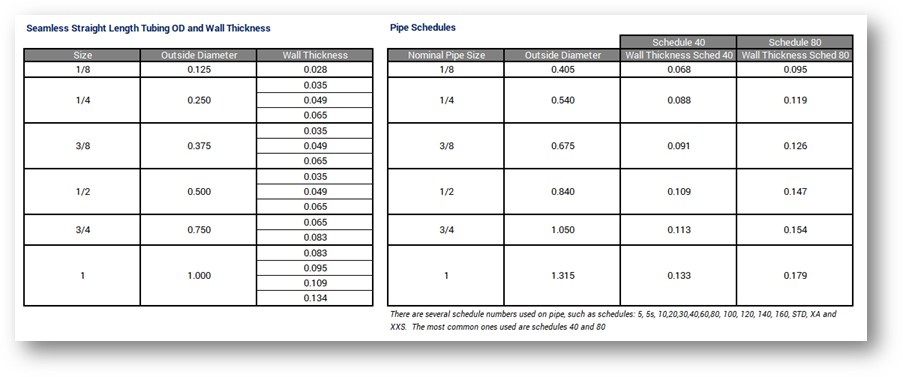At SSP Fittings Corp., we are a premier manufacturer of tube, pipe, weld, and adapter fitting solutions. Throughout our nearly 100 years in business, we have received a wide variety of questions from customers about fittings. Here, the SSP team provides answers to several of these frequently asked questions (FAQs).
What is the difference between tube fittings and pipe fittings?
As their name may imply, tube fittings are specifically designed for use with tubes, while pipe fittings are designated for use with pipes. Many people use the terms “tube” and “pipe” interchangeably. While the two have some similarities, they are distinct product groups. Here are the main distinctions:
- Tubes are round, hollow components identified by outside diameter (OD) and wall thickness (WT). They are utilized for pressure equipment, mechanical, and instrumentation system applications.
- Pipes are round hollow components identified by the nominal pipe size (NPS), which provides a rough estimate of the conveyance capacity. They are generally used for fluid distribution and transportation applications.
To explore the differences in specifications and designs between tube and pipe fittings, check out our dedicated pages for these fitting types below:
What pipe fitting thread types are available and how do they seal?
Pipe fittings come in a variety of threads types and sizes. Some of the most common thread types are National Pipe Tapered/Straight (NPT/NPS), Male/Female Iron Pipe (MIP/FIP), British Standard Pipe Tapered/Straight (BSP(T)/BSP(S)), and National Unified Special (UNS).
Are tube fittings interchangeable?
To interchange means that the nut and ferrule(s) combination from one brand can be assembled with the body of a compatible brand, and vice-versa, to produce a working, leak-tight fitting. Whether a tube fitting is interchangeable or not will depend on if a brand has specified and certified that their fittings will be compatible with the other brand. Check with the manufacturer to see if they offer resources on the interchangeability of their products – you can find SSP’s guide to interchanging and intermixing our components with those from Swagelok®, Parker Hannifin®, and Hoke® here.
What are the different types of pipe fittings?
There are many different types of pipe fittings, each of which serves a different role in their end systems. Some of the most common types available are elbows, reducers, couplings, unions, adapters, plugs, caps, and valves.
What is the difference between male and female pipe fittings?
When talking about pipe fittings, the terms “male” and “female” refer to the threads. Male pipe fittings feature threads on an outer surface, while female pipe fittings have the threads on an inner surface.
What are socket weld fittings?
Socket weld fittings feature recessed areas designated for pipe insertion. Once the pipes are properly inserted into the fitting, the assembly undergoes welding to join the pipe to the fitting. These fittings are generally used for pipes with small diameter (NPS 2 or smaller).
What is a coupling pipe fitting?
Coupling pipe fittings are short and straight pieces of pipe with sockets or female pipe threads at either or both ends. They allow for the joining of two pipes of equal or dissimilar sizes to help extend or end pipe runs.
How do I figure out my fitting size?
Determining the right fitting size for tubing systems and piping systems necessitates measuring the pipe/tube appropriately. Fittings for male pipes/tubes are based on the measurement of the outside diameter (OD) of the pipe/tube, while fittings for female pipes/tubes are based on the measurement of the inside diameter (ID) of the pipe/tube.
For tubing systems, once you have the measurement in hand, it is relatively easy to select the right tubing fitting. For example, for a 1/2-inch tube, you need a 1/2-inch fitting.
For piping systems, identifying the right size fitting is more involved. Pipe sizes are indicated in terms of nominal diameter rather than actual diameter. As a result, once you have the actual pipe diameter measurement in hand, you need to use a nominal diameter conversion chart to determine the nominal diameter measurement.
Here is a tubing and pipe sizing chart for reference:

Choose SSP for Your Fittings
At SSP, our primary goal is to be the installer’s supplier of choice.
We take pride in the exceptional attention to detail and service that we provide to each and every customer and production, even beyond the completion of a project. Our global network of distributors offer personalized, local support, and we are proud to provide products made in America.
Explore our fittings solutions portfolio by clicking here.
Have any other general questions about fittings that we didn’t answer here? Contact us and we’ll be happy to help!



